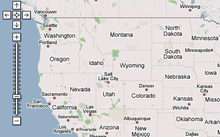I got my first GPS device just two years ago, and I like it a lot. Nonetheless, I'm ready to replace the gadget with something better: my phone.
GPS devices provide turn-by-turn navigation, and they're incredibly useful when you are going to unfamiliar places. They give you a three-dimensional view of your current position and suggested path, and typically give you directions via voice prompt.
But over the past year, that same feature has become commonplace on cell phones from all the major carriers. Last month, with its latest update to the iPhone's operating system, Apple brought the ability to do turn-by-turn navigation to its hit smart-phone.
Since that update, I've been testing out two different navigation programs on my iPhone. They're not perfect and, in some ways, aren't as good as my stand-alone GPS device. But they do have one big advantage -- because they're on my phone, they're with me all the time.
My GPS device is an entry-level model from TomTom, and it's been great. The device helped guide my family to Yosemite in May and helped us navigate the back roads of rural Tuscany in Italy when we traveled there last year.
But as much as I like my TomTom device, I don't use it very often. Because I don't need it for my daily commute and worry about it being stolen, I typically don't keep it in my car. And lately, I've just been using my phone instead.
Phone-based turn-by-turn navigation is nothing new, of course, even if it is new to the iPhone. Sprint and Verizon have been offering the feature on at least some of their phones for years.
But the feature has been slow to catch on. Sprint and Verizon until recently offered it on only a handful of handsets, and the other two major carriers, AT&T and T-Mobile, didn't start offering the service on any of their phones until last year.
A recent Forrester Research study indicated that just 4 percent of U.S. adults own or use a phone-based navigation system and just 2 percent use it regularly.
But Forrester and other research firms are optimistic those numbers will rise rapidly in the near future. Frost & Sullivan, a consulting firm, estimates that the number of subscribers to phone-based navigation systems will grow from about 4.5 million last year to 28 million by the end of 2013.
I've been relying on my phone for most of my navigation needs since I got it last year. I've been using the Google Maps application preinstalled on the iPhone. Although it doesn't do turn-by-turn navigation, it will plot a course that you can follow.
The new iPhone programs go well beyond Google Maps to offer true turn-by-turn navigation. There are now at least four different developers with such programs in the iTunes App Store, many of whom offer multiple programs, each with a map of a different area of the country or world. And more such programs are on the way.
The two that I've played with are Gokivo and AT&T Navigator. Both programs work adequately. The course maps are generally easy to follow. And on the AT&T Navigator, at least, the voice prompts were generally clear.
One benefit of such programs over many stand-alone GPS devices is that they can tap into your phone's data connection. The Navigator, for instance, can get real-time traffic information and use that to plot or adjust suggested routes. Both programs allow you to search for nearby restaurants, gas stations and other establishments, and then give you directions.
Gokivo has some nice features that Navigator lacks. You can play music from your iPod library directly from the program. And it will let you pull in addresses from your list of contacts.
But neither program is ideal. Unlike my TomTom, both programs display their maps in portrait, not landscape mode, which means you get a narrow view of your course. And they both tend to refresh their maps slowly. As a result, the on-screen motion can be halting, which means you may be farther down the road than the application thinks you are.
What's more, the programs cost $10 a month each on top of your normal data fees. There's an additional $1 charge to download the Gokivo application, though you can download AT&T Navigator for free. That can get pricey over the course of the year, especially since you can buy a low-end GPS device these days for less than $100.
And you'd better make sure you have a car charger when you're using these applications. Because they keep the screen on constantly and frequently ping the data network to refresh their maps, they can run down your battery very quickly.
Those aren't minor quibbles. I'm not convinced that I'll stick with either Gokivo or AT&T Navigator for the long haul. But the programs will get better and, if they don't, I can try others.
Regardless, I'm probably not going back to my TomTom. If only for the convenience factor, having GPS navigation on my phone is a better experience.
___
(c) 2009, San Jose Mercury News (San Jose, Calif.).
Visit MercuryNews.com, the World Wide Web site of the Mercury News, at www.mercurynews.com
Distributed by McClatchy-Tribune Information Services.




















